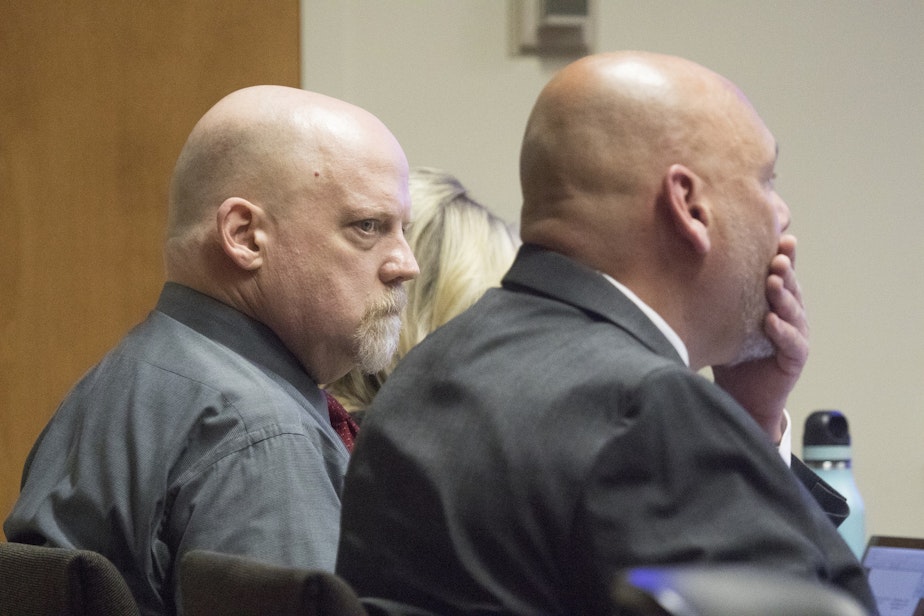Talbott defense doubles down on rape versus consensual sex angle in appeal

William Talbott II, who was found guilty two weeks ago of murdering a young Canadian couple on an overnight road trip to Seattle, has asked for a new trial.
In an appeal filed this week, Talbott’s attorneys pointed to a story published on Sunday in the Everett Herald, in which three jurors explain why they didn’t come around to the defense’s position.
This was a 32-year-old cold case that never got traction.
In 1987, Tanya van Cuylenborg, 18, and Jay Cook, 20, were dispatched to pick up furnace parts for the family business. A week later, they were found murdered, their bodies dumped 65 miles apart.
Talbott had never been a suspect in the murders, his name never mentioned, but then a new technology emerged, and he was snared.
The case thawed last year with the development of a new way of catching criminals: genetic genealogy.
In May 2018, genetic genealogists uploaded a DNA profile from a semen sample found at one of the crime scenes. The mysterious genetic profile had never turned up a precise individual.
But with this new way of finding criminals, genealogists would find a relative who had uploaded their own genetic profile – usually to find extended relatives and build out their family tree. That person’s ancestry information might point to the prime suspect.
In the Talbott case, genealogists found two second cousins, one on Talbott's mom's side and one on his dad's. Finding such close relations was considered a coup in genetic genealogy.
Within days, the genealogists with Parabon Nanolabs pinpointed Talbott. A DNA sample taken from a cup that Talbott had discarded matched the semen sample from the crime scene.
It was the first time in U.S. history that someone found using genetic genealogy had sat trial. The method wasn’t contested, nor was it considered in the appeal. Rather, the defense attorneys focused on the jurors’ reasons for why they found Talbott guilty.
Points made in the appeal:
1. When one of the jurors asked the judge for a map of western Washington, he was denied. The juror drew a map from memory, which the defense viewed as a form of legal insubordination.
From the Herald story: The juror “made a map from memory. He drew the couple’s route from Victoria to Port Angeles to Hoodsport to Allyn to Bremerton – to thin air.”
2. One juror found it suspicious that the defense resisted sharing where Talbott lived at the time of the killings.
“You wouldn’t be too worried about it if you felt it would exonerate him,” the juror said, according to the Herald story.
3. The jury had been instructed not to consider that Talbott hadn’t talked … but that weighed on at least one juror who told the Herald, “It is human nature to want to hear his side of the story.”
4. In the appeal, the defense said that the state’s “entire case rests on a single proposition: that the sexual contact between Mr. Talbott and Ms. Van Cuylenborg was rape and not consensual.”
The defense did not dispute that Talbott and Van Cuylenborg had sexual contact in 1987. Rather, the defense said that they had sex, and someone else did the killing.
But Talbott's attorneys have insisted this was not rape. In court, one of the defense attorneys said the presence of the young woman’s fluids mixed with Talbott's semen indicated consensual sex.
One of the jurors found that explanation flabbergasting, according to the Herald. (It has been well documented that some women will not resist rape to appease their attacker.)
The defense doubled down on rape versus consensual sex in the appeal.
There were no injuries “consistent with sexual assault,” the appeal said, or “evidence of physical restraint.”
Not mentioned in the appeal was what brought the jurors to their final, unanimous decision. According to the Herald, the jurors determined there were about eight hours when Van Cuylenborg and Cook met the person who would murder them.
It simply did not compute for them that Van Cuylenborg, on a short trip with her boyfriend, and on her period, would “consent to unprotected sex with a random stranger, then encounter another random stranger, who killed her with a gun and happened to leave behind no DNA.”


